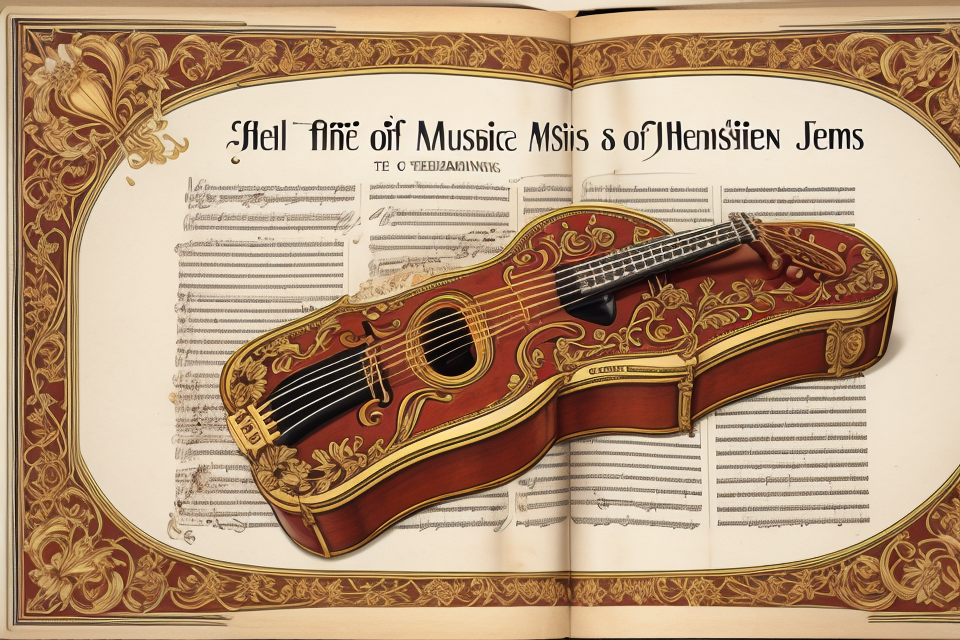Music is a language that speaks to the soul, and one of the most intriguing aspects of music is its style. Understanding musical styles is crucial for any music lover, whether you’re a fan or a musician. In this comprehensive guide, we’ll delve into the world of musical styles, exploring the various elements that make up a style and how to describe them. From classical to rock, jazz to hip-hop, we’ll uncover the unique characteristics that define each genre and learn how to articulate them in a way that captures the essence of the music. Whether you’re a seasoned musician or a newcomer to the world of music, this guide will help you navigate the vast landscape of musical styles with confidence and flair. So, let’s embark on this journey together and discover the magic of music through its styles.
Defining Musical Style
Characteristics of Musical Style
Musical style refers to the unique features that distinguish one piece of music from another. There are several characteristics that contribute to the distinctiveness of a musical style, including melody, harmony, rhythm, timbre, and texture.
Melody
Melody refers to the sequence of single pitches that make up a musical line. It is the most recognizable and memorable aspect of a piece of music, and is often used to convey emotion and express meaning. Different musical styles use melody in different ways, ranging from simple and repetitive melodies in folk music to complex and intricate melodies in classical music.
Harmony
Harmony refers to the combination of two or more pitches sounding at the same time. It is the foundation of most Western music, and is used to create a sense of unity and coherence in a piece of music. Different musical styles use harmony in different ways, ranging from simple and homophonic harmonies in pop music to complex and polyphonic harmonies in jazz and classical music.
Rhythm
Rhythm refers to the pattern of stressed and unstressed beats in a piece of music. It is the foundation of most non-Western music, and is used to create a sense of movement and energy in a piece of music. Different musical styles use rhythm in different ways, ranging from simple and steady rhythms in rock music to complex and polyrhythmic rhythms in jazz and classical music.
Timbre
Timbre refers to the unique tone color of a particular instrument or voice. It is the distinguishing characteristic of a particular instrument or voice, and is used to create a sense of individuality and identity in a piece of music. Different musical styles use timbre in different ways, ranging from the use of brass instruments in jazz and rock music to the use of strings in classical music.
Texture
Texture refers to the layering of different musical elements in a piece of music. It is the distinguishing characteristic of a particular style, and is used to create a sense of complexity and depth in a piece of music. Different musical styles use texture in different ways, ranging from simple and homophonic textures in pop music to complex and polyphonic textures in jazz and classical music.
Influence of Culture and History
The cultural and historical context of a particular time and place has a significant impact on the development of musical styles. Musical styles often reflect the values, beliefs, and customs of a society, and they can also serve as a means of expressing cultural identity. In this section, we will explore the influence of culture and history on musical styles.
Regional Differences
Regional differences play a crucial role in shaping musical styles. Different regions have their own unique musical traditions, which are often influenced by the natural environment, climate, and cultural practices of the area. For example, the blues, a genre of music that originated in the southern United States, is heavily influenced by the Mississippi Delta region’s humid climate, the melancholic mood of the people, and the African American experience of slavery and segregation. Similarly, the music of the Scottish Highlands, with its fast-paced rhythms and haunting melodies, reflects the rugged landscape and the harsh weather conditions of the region.
Time Period
The time period in which a musical style emerges can also have a significant impact on its development. Musical styles often reflect the social, political, and economic conditions of a particular era. For example, the Jazz Age of the 1920s was characterized by a newfound sense of freedom and experimentation, which led to the development of a new form of jazz that was more improvisational and energetic than its predecessors. Similarly, the social and political upheaval of the 1960s gave rise to a new wave of protest music, including folk music and rock music, that reflected the concerns and aspirations of a generation.
Social and Political Context
The social and political context of a particular time and place can also have a profound impact on the development of musical styles. Music can be a powerful tool for expressing social and political ideals, and it can also serve as a means of resistance against oppressive regimes. For example, the music of the Civil Rights Movement in the United States, including gospel music and freedom songs, played a crucial role in mobilizing a movement and inspiring change. Similarly, the punk rock movement of the 1970s, with its raw energy and DIY ethos, reflected a generation’s disillusionment with mainstream culture and its desire for a more authentic and rebellious lifestyle.
Describing Musical Style
Genres and Subgenres
When describing musical style, it is important to consider the genre and subgenre of the music. Different genres of music are characterized by distinct characteristics and styles, and within each genre, there may be various subgenres that further refine the style of the music.
Some of the most common genres of music include:
- Classical: This genre of music encompasses a wide range of styles and periods, from medieval to contemporary. Classical music is often characterized by its complex structure, technical demands, and use of orchestral instruments.
- Jazz: Jazz is a genre of music that originated in the African-American communities of the southern United States. It is characterized by its improvisational nature, use of blue notes, and rhythmic complexity.
- Rock: Rock music is a genre of popular music that originated in the 1950s. It is characterized by its use of electric instruments, strong rhythms, and often features a vocalist.
- Pop: Pop music is a genre of music that is popular among a wide audience. It is often characterized by its catchy melodies, upbeat tempo, and simple lyrics.
- Electronic: Electronic music is a genre of music that uses electronic devices and instruments to create sound. It encompasses a wide range of styles, from ambient to techno.
- Hip-hop: Hip-hop is a genre of music that originated in the African-American and Latino communities of the Bronx in New York City. It is characterized by its use of rap, DJing, and MCing, as well as its emphasis on social and political commentary.
Within each genre, there may be various subgenres that further refine the style of the music. For example, within the genre of rock, there are subgenres such as heavy metal, punk, and grunge. Similarly, within the genre of hip-hop, there are subgenres such as gangsta rap and alternative hip-hop.
It is important to note that the boundaries between genres and subgenres can be somewhat fluid and subjective, and that there may be some overlap or blending of styles within and between genres. However, understanding the basic characteristics and styles of different genres and subgenres can help to provide a framework for describing musical style in a more meaningful and accurate way.
Analyzing Musical Elements
In order to fully understand and describe a musical style, it is important to analyze the various musical elements that contribute to its sound. These elements include scales and modes, chord progressions, rhythmic patterns, texture and layering, and instrumentation and orchestration.
- Scales and Modes: Scales and modes are the foundation of a musical style, as they define the pitches and intervals used in a composition. Each scale and mode has its own unique sound and can be used to create different moods and emotions in a piece of music.
- Chord Progressions: Chord progressions are the sequence of chords used in a composition, and they play a crucial role in defining the harmonic structure of a piece of music. Different chord progressions can create different emotional responses and can be used to convey different moods and messages.
- Rhythmic Patterns: Rhythmic patterns are the patterns of beats and rhythms used in a composition, and they can greatly affect the feel and energy of a piece of music. Different rhythmic patterns can create different moods and can be used to convey different emotions and messages.
- Texture and Layering: Texture and layering refer to the way in which different musical elements are combined to create a unique sound. Different textures and layering techniques can create different moods and can be used to convey different emotions and messages.
- Instrumentation and Orchestration: Instrumentation and orchestration refer to the choice of instruments used in a composition and the way in which they are arranged. Different instruments and orchestration techniques can create different moods and can be used to convey different emotions and messages.
Vocabulary for Describing Musical Style
Dynamics
In music, dynamics refers to the volume or loudness of a piece. This includes elements such as piano (soft), forte (loud), and crescendo/decrescendo (getting louder/quieter). Understanding dynamics is crucial in conveying the emotional impact of a piece and helping the listener to follow the musical narrative.
Tempo
Tempo refers to the speed or pace of a piece of music. It is typically measured in beats per minute (BPM) and can vary greatly between different styles and genres. Understanding tempo is essential in understanding the rhythm and movement of a piece, as well as in determining the appropriate speed for performance.
Harmony
Harmony refers to the combination of two or more notes played simultaneously. It can include elements such as chords, progressions, and counterpoint. Understanding harmony is important in understanding the structure and progression of a piece, as well as in creating a sense of tension and resolution.
Melody
Melody refers to a sequence of single pitches that make up a musical line. It can include elements such as rhythm, pitch, and duration. Understanding melody is important in understanding the structure and progression of a piece, as well as in creating a sense of memorability and emotional impact.
Timbre
Timbre refers to the unique tone color or quality of a sound. It is determined by factors such as the instrument or voice used, the playing technique, and the acoustic environment. Understanding timbre is important in distinguishing between different instruments or voices, as well as in creating a sense of individuality and character in performance.
Texture
Texture refers to the layering and combination of different musical elements, such as melody, harmony, and rhythm. It can include elements such as monophonic (single line), homophonic (one melody with accompaniment), and polyphonic (multiple independent lines). Understanding texture is important in understanding the structure and progression of a piece, as well as in creating a sense of complexity and depth in performance.
Writing About Musical Style
Writing about musical style requires a delicate balance of creativity and accuracy. Here are some tips for writing about musical style in a way that is both engaging and informative:
- Finding the right words: The first step in writing about musical style is to find the right words to describe what you hear. This can be challenging, as music is a highly subjective experience. However, by using vivid and descriptive language, you can help your readers to imagine the sounds you are describing.
- Using metaphors and similes: Metaphors and similes can be powerful tools for describing musical style. For example, you might compare the sound of a guitar to “a waterfall of notes” or “a swarm of bees.” These comparisons can help to evoke the feeling of the music and make it more accessible to readers.
- Being specific and descriptive: To write about musical style effectively, you need to be specific and descriptive. This means using adjectives and adverbs to describe the music, such as “fast” or “loud” or “mournful.” You should also pay attention to the instrumentation, tempo, and rhythm of the music, and describe these elements in detail.
- Avoiding clichés: Finally, it’s important to avoid clichés when writing about musical style. Clichés are overused expressions that have lost their impact over time. For example, describing a song as “catchy” or “upbeat” is not very helpful to the reader. Instead, try to find more specific and accurate ways to describe the music.
Evaluating Musical Style
Subjective and Objective Evaluation
When evaluating musical style, it is important to consider both subjective and objective factors.
Personal Taste and Preference
Personal taste and preference play a significant role in evaluating musical style. This involves assessing whether a particular piece of music resonates with the individual’s personal tastes and preferences. It is subjective in nature, as each person’s preferences and tastes are unique. However, it is still an important factor to consider when evaluating musical style, as personal taste and preference can greatly influence one’s perception of a particular piece of music.
Technical Proficiency
Technical proficiency is another important factor to consider when evaluating musical style. This involves assessing the technical skill and proficiency of the musicians or performers involved in the piece of music. Technical proficiency includes factors such as accuracy, precision, and control. It is objective in nature, as it can be measured and evaluated based on specific criteria. However, subjective factors such as personal taste and preference can still influence one’s perception of technical proficiency.
Historical Significance
Historical significance is also an important factor to consider when evaluating musical style. This involves assessing the cultural and historical context of the piece of music, as well as its impact on the music industry and society as a whole. It is objective in nature, as it can be evaluated based on historical facts and cultural context. However, subjective factors such as personal taste and preference can still influence one’s perception of historical significance.
Overall, evaluating musical style involves considering both subjective and objective factors, including personal taste and preference, technical proficiency, and historical significance. It is important to approach evaluations with an open mind and consider all relevant factors in order to gain a comprehensive understanding of musical style.
Appreciating Diversity in Musical Style
As we delve deeper into the world of music, it is important to appreciate the diversity of musical styles that exist. Each style has its own unique characteristics, history, and cultural significance. In this section, we will discuss how to recognize the value of different styles, understand the context of different styles, and avoid cultural appropriation.
Recognizing the Value of Different Styles
Music is a reflection of culture, and each style of music has its own cultural background. By understanding and appreciating the different styles of music, we can gain a deeper understanding of the cultures they represent. This appreciation can lead to a broader perspective on the world and a greater appreciation for the diversity of human experience.
To recognize the value of different styles, it is important to approach each style with an open mind and a willingness to learn. This means listening to and learning about different styles of music, understanding the historical and cultural context in which they were created, and respecting the cultural significance of each style.
Understanding the Context of Different Styles
Music is often influenced by the historical and cultural context in which it was created. By understanding the context of different styles of music, we can gain a deeper appreciation for the music itself. This understanding can also help us to avoid cultural appropriation, which is the unauthorized use of elements of one culture by another.
To understand the context of different styles, it is important to research the history and cultural significance of each style. This research can include learning about the historical events that influenced the creation of the music, the cultural traditions that shaped the music, and the social and political context in which the music was created.
Avoiding Cultural Appropriation
Cultural appropriation is a sensitive and controversial topic in the world of music. It is important to be aware of the potential for cultural appropriation and to avoid it whenever possible. This means respecting the cultural significance of different styles of music and avoiding the unauthorized use of elements of one culture by another.
To avoid cultural appropriation, it is important to approach each style of music with respect and appreciation for its cultural background. This respect can be shown by learning about the history and cultural significance of each style, understanding the cultural traditions that shaped the music, and avoiding the use of cultural elements in a way that is disrespectful or inappropriate.
FAQs
1. What is musical style?
Musical style refers to the unique characteristics and features that define a particular type of music. It encompasses various elements such as rhythm, melody, harmony, timbre, texture, and form, among others. Musical style is what makes a particular piece of music distinct from others and identifiable as belonging to a specific genre or category.
2. How do you describe a musical style?
Describing a musical style involves identifying and analyzing the various elements that make up the music. This includes the melody, harmony, rhythm, timbre, texture, and form, among others. To describe a musical style accurately, it is important to have a good understanding of the history and context of the music, as well as the cultural and social influences that shaped it.
3. What are the different types of musical styles?
There are countless musical styles, and they can be broadly categorized into various genres, such as classical, jazz, rock, pop, hip-hop, electronic, and many more. Each genre has its own unique characteristics and features, and within each genre, there are sub-genres and variations. For example, within the genre of classical music, there are sub-genres such as baroque, classical, and romantic, each with its own distinct style and characteristics.
4. How do you identify a musical style?
Identifying a musical style involves listening to the music and analyzing its various elements. This includes the melody, harmony, rhythm, timbre, texture, and form, among others. By identifying these elements and comparing them to other pieces of music, it is possible to determine the specific style of the music and place it within a particular genre or category.
5. What is the importance of understanding musical styles?
Understanding musical styles is important for several reasons. It helps to develop a deeper appreciation and understanding of music, as well as to recognize and appreciate the unique characteristics and features that define different types of music. Additionally, understanding musical styles can help to identify the cultural and social influences that shaped the music, providing insight into the historical and cultural context in which it was created. Finally, understanding musical styles can also help to facilitate communication and collaboration between musicians and music enthusiasts from different backgrounds and genres.



